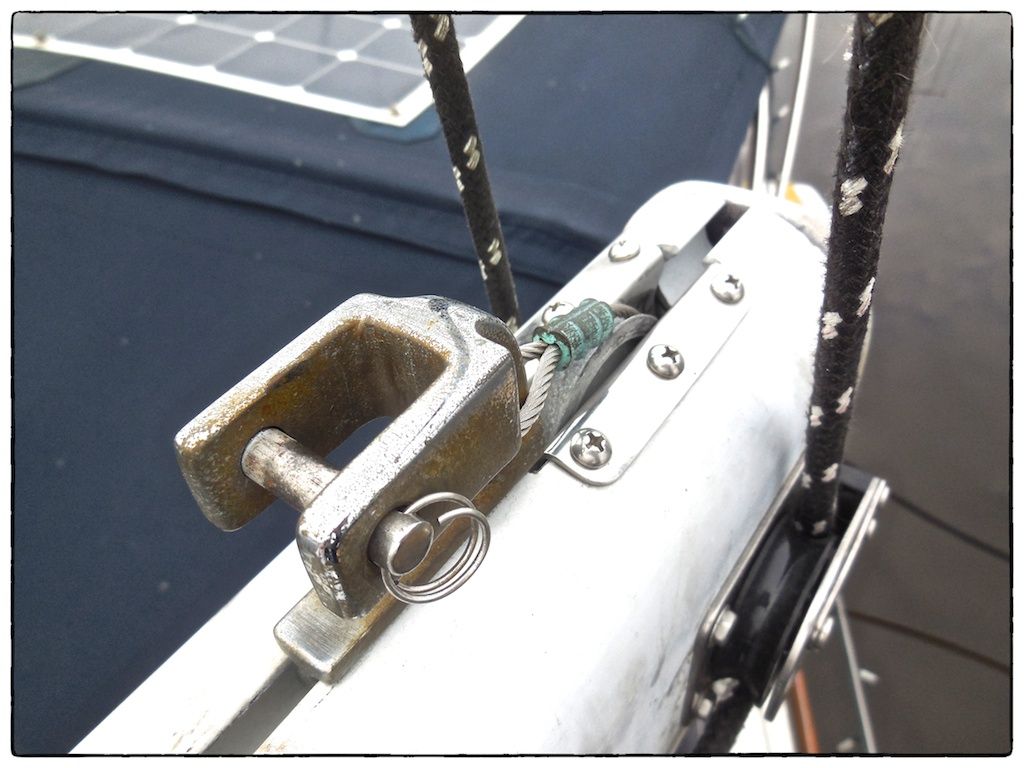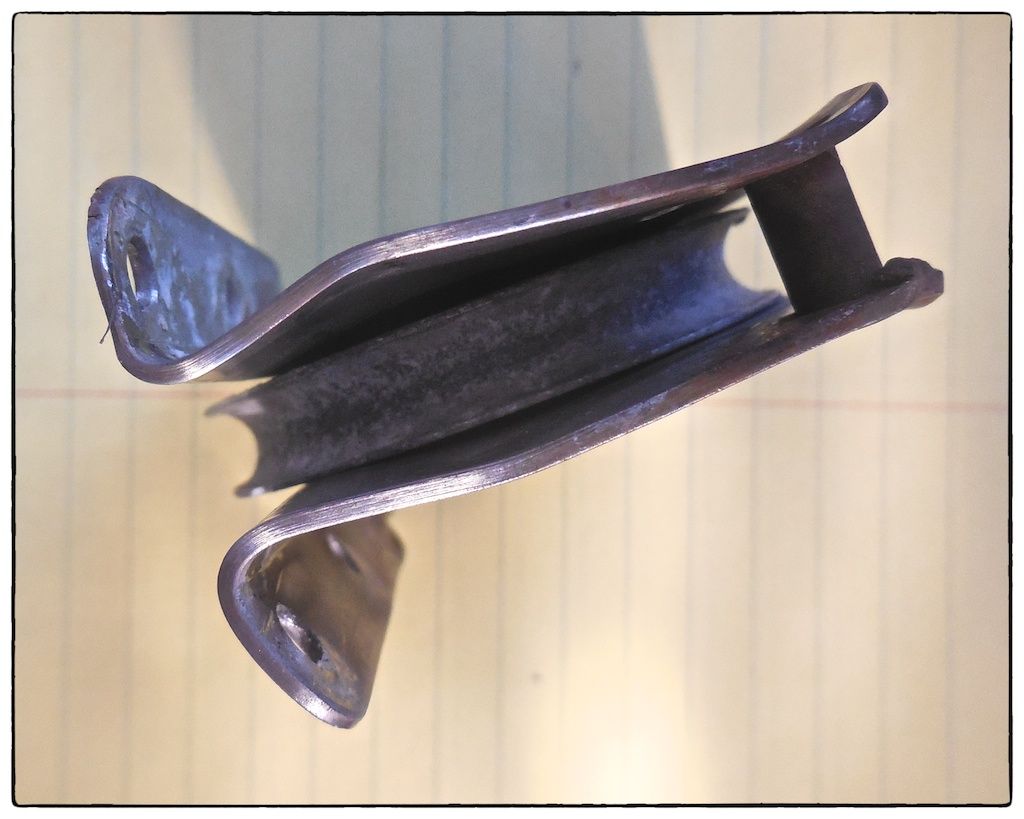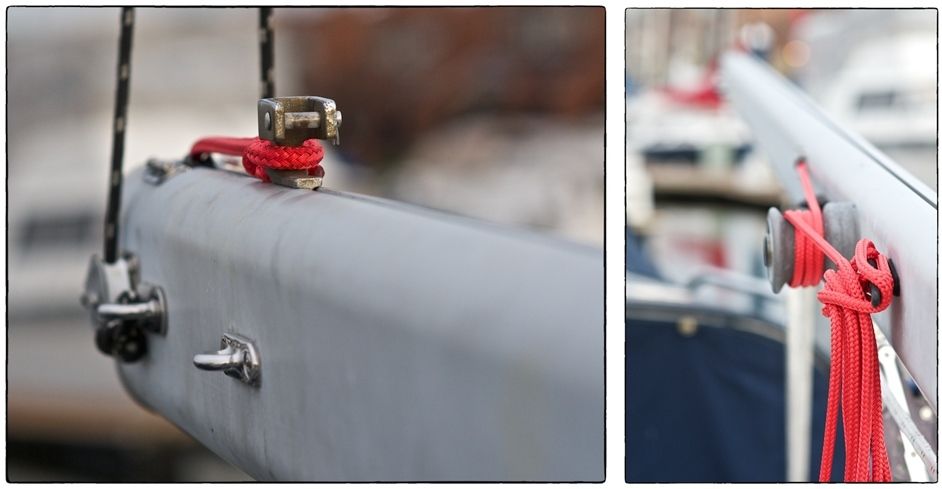Outhaul Replacement & Upgrade
--Blogpost written by Bob
The original outhaul on s/v Rainy Days was 32 years old. It was clearly a wire-to-rope line and the exit sheave in the boom's end was made only for the wire portion of the outhaul.
Background
When I started this project I was planning for our new mainsail to be loose footed to improve performance. In other words, it wouldn't be fastened to the boom using a bolt rope in the groove on the top of the boom--the clew would be the mainsail's only attachment point to the boom. As I got into this project a little further I realized that the clew slug may not be able to take the single point load if we were caught in very high winds before we could get the main reefed. My concern was that the high loads would either break the clew slug or pull it out of the track in the boom.
To preserve the integrity of the clew slug and the boom, I switched the new sail design at the last minute away from the loose footed main. However, I was still intent on changing the outhaul to all rope, getting rid of a wire-to-rope splice. Changing the outhaul to all rope meant that I also had to changeout the exit sheave (sometimes called a box sheave because of its shape) to handle the larger diameter line.
 |
| Shown are the original clew slug and exit sheave at the end of the boom. Since the original exit sheave is intended for only wire rope, it had to be replaced as part of this project. |
Exit Sheave
I had to grind the stainless steel screw heads completely off in order to remove the old exit sheave. The stainless steel screws were installed into tapped holes in the aluminum boom and they were solidly fused together by the corroding aluminum.
 |
| At some point in time, the old exit sheave was clearly overloaded and the box-like structure became deformed. |
The only available exit sheave that could handle rope and match the original 6-bolt method of attachment to the boom is made by Schaefer Marine. It can handle up to 1/2-inch diameter rope.
 |
| Fortunately, the holes in the new exit sheave are farther away from the boom's centerline--I don't have to be concerned about interference with the old mounting holes. |
The original cutout in the boom for the exit sheave was about 9/16-inch wide. The new exit sheave had a width of 13/16-inch--so, the cutout in the boom had to be enlarged (by 1/16-inch on each side of centerline) for the new exit sheave--I used a portable grinder for this operation and took it very slow, frequently checking the current width of the opening.
Outhaul Line
Expecting to find a frayed wire-to-rope splice, I was surprised to find a simple bowline knot tied to a loop in the wire rope. Except for the exterior of the rope portion of the line getting a little dirty, this outhaul line probably would have lasted another 32 years.
 |
| I expected to find a frayed wire-to-rope splice inside the boom--not a simple bowline tied to a loop in the wire rope--it was all in good condition. |
While the new exit sheave could handle up to 1/2-inch diameter rope, I decided to use a 3/8-inch diameter low-stretch rope (New England XLS) in a color that was completely different from all the other lines on our boat, solid red. The length of the new all rope outhaul is a little greater than two times the length of the boom (35 feet). I pulled the new rope through the boom using the messenger line while I installed the new exit sheave.
Summary
John Vigor has a unique viewpoint on a sailor's "anticipative style" of thinking. He writes in his blogpost titled Earning Luck at Sea (September 24, 2015) "I always imagine that every boat has a secret black box that collects the Brownie points you earn for every seamanlike action you take. Every time you check the oil level on the engine, no matter how awkward it is to reach the dipstick, you get a point. Every time you buy a real paper chart of an area you want to explore, you get a point. Every time you get up in the middle of the night and go on deck in the rain to check your anchor bearing, you get a point. For that matter, you also get a point for even having an anchor bearing to begin with. You get points (quite a few actually) simply for imagining what would happen on deck and down below if your boat were turned turtle by a large wave, and doing something about it. And so forth, ad infinitum. As I’ve said before, good sailors don’t live in the moment. They anticipate what’s ahead.
Now, it can happen to any boat, no matter how well found and well handled, that a time will come when human skill and effort can do no more to rescue it from a perilous position. But if you have points in the black box you can spend them to ensure that your boat will survive. Actually, you don’t have to withdraw the points. They expend themselves automatically as necessary.
Other boats battling the same circumstances as you, but lacking points in their black boxes, are less likely to survive. Those who don’t understand the mysteries of small boats sailing on big waters will say you were just lucky. And, depending on how you define luck, or good fortune, they may be right. What they don’t know is that you earned your luck."
This project cost approximately $250 (exit sheave and rope) and took about eight hours to complete. I replaced a 32-year old line that was actually in a good condition and an exit sheave that was deformed from high loads at some point in time. If nothing else, I hope I've earned some brownie points for my black box.
Thanks for following our blog!



No comments:
Post a Comment